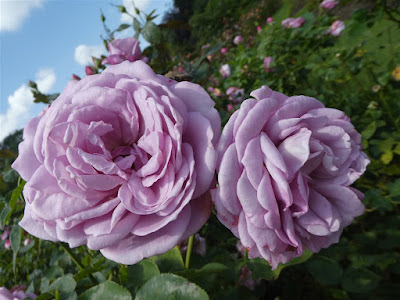Enough museums for a while. Before tackling the V&A, again, we decided to do a couple days outside, seeing a park or two and a part of town completely new to us. Tuesday, August 10th, we saw Temple, a part of London not on the must-see list but nonetheless important. Executive summary: the Order of the Knights Templar were welcomed in England by Henry I, built their temple at Temple in the mid-12th, fell out of favor with the Pope and were superseded by the Hospitallers, then the whole thing was Dissolved by Henry VIII, and then...James I gave the whole shebang to...the lawyers. Evidently he had not seen Henry VI, Part 2, Act IV, Scene 2, where Dick the Butcher utters one of the Bard's most beloved lines: "First thing we do, let's kill all the lawyers."
Explaining the Inns of Court and the organization of the legal profession here is beyond the scope of this blog. Probably beyond any scope. Having studied the Michelin Green Guide and the relevant Wikipedia articles for, oh, a good ten minutes, I think, the best way to understand it all is as a remnant of the Medieval guild system and of the English split from Roman law, favored by the Church, which also held that legal education and practice was to be the business of the clergy. The result of said split is that we get English Common Law, practiced by non-clerics, who needed to organize and regulate themselves and who also needed a place to practice. They'd been operating in the Temple area from the time of the Edwards, and apparently James I just formalized what had already been growing for centuries. Queen Elizabeth II recently re-upped the whole arrangement on the 400th anniversary of James' action.
In any case, if you want to be a barrister here, you have to be a member of one of the four Inns of Court located at Temple: Gray's Inn, Lincoln's Inn, Inner Temple, or Middle Temple. Also probably pass the exam and pay some hefty dues. (Apart from the state bar associations, there's nothing very similar in the US; and, of course, in the US there are just lawyers, not barristers and solicitors and what have you, as here.) The Temple area, consisting of many blocks from the Victoria Embankment on the river up to Fleet Street, where the Royal Courts are, is a centuries-old combined office and residential center for the upper legal profession. Many blocks, many buildings, streets, alleys, gardens, restaurants, and such. Here you could, if you wanted to, eat, sleep, and practice law 24x7. Also maybe keep an eye out for Dick the Butcher.
 |
| Entrance to the Royal Courts on Fleet St. |
 |
| Quite a huge, flamboyant affair |
 |
So you duck in what might have been a covered alley, pass
between some buildings, and you're in Legal World |
 |
Street scene; prior to COVID one would have seen many suits,
maybe even a black gown and wig; but not anymore |
 |
But there it is, The Temple, 1180s, modeled after the Temple of
the Holy Sepulchre, Jerusalem, and, in fact, consecrated by the
high holy guy himself back then |
 |
| "Mother Church of the Common Law"--alas, closed due to COVID |
 |
| Entrance |
 |
Detail; the whole area was severely damaged in 1940, rebuilt;
much of the original remains |
 |
| Among the many buildings |
 |
| Some of the tenants |
 |
| The whole nicely landscaped |
 |
Memorials here and there; Temple figured importantly in Dickens'
writings, also some in 17th century writings |
 |
Middle Temple Hall, where Queen Elizabeth I
attended the first performance of Twelfth Night |
 |
| Fountain Court, Middle Temple |
 |
| Toward the gardens and the river |
 |
| Paschal Lamb, symbol of Middle Temple |
 |
| Legal notice as you leave the premises |
 |
| Embankment entrance |
 |
Alas, the gardens had just closed by the time we got there, so we had to content ourselves strolling along the embankment |
 |
| Apparently her last public appearance |
 |
Marking the boundary between City of London and Westminster |
 |
| River view |







































































